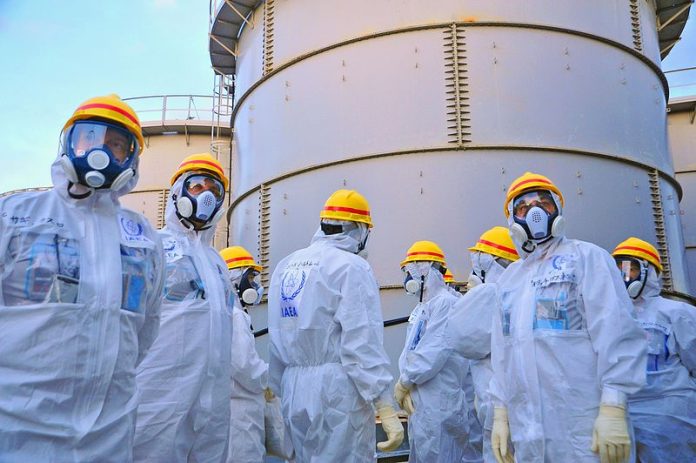International Atomic Energy Agency (IAEA) has confirmed that the tritium level in the fourth batch of diluted treated води, which Tokyo Electric Power Company (TEPCO) started discharging on 28 February 2024, is far below the Japan’s operational limit.
Experts stationed at the site of the Fukushima ядерний влада station (FDNPS) took samples after the treated води was diluted with морська вода in the discharge facilities on 28 February. The analysis confirmed that the tritium concentration is far below the operational limit of 1,500 becquerels per litre.
Japan is discharging the treated води from the FDNPS in batches. The previous three batches – a total of 23,400 cubic metres of води – were also confirmed by the IAEA to have contained tritium concentrations far below operational limits.
Since the accident in 2011, води is needed to continually cool the melted fuel and fuel debris at the Fukushima Daiichi NPS. In addition to the води pumped in for this purpose, groundwater also seeps into the site from the surrounding environment, and rainwater falls into the damaged reactor and turbine buildings. When води comes in contact with melted fuel, fuel debris and other radioactive substances, it becomes contaminated.
The contaminated води is treated through a filtration process known as Advanced Liquid Processing System (ALPS) which uses a series of chemical reactions to remove 62 radionuclides from contaminated water before being stored. However, tritium cannot be from the contaminated water through ALPS. Tritium can be recovered when it is highly concentrated in small amounts of water, for example at ядерний fusion facilities. However, the stored water at the Fukushima Daiichi NPS has a low concentration of tritium in a large volume of water and so the existing technologies are not applicable.
Tritium is a naturally occurring radioactive form of hydrogen (half-life 12.32 years) that is produced in the atmosphere when cosmic rays collide with air molecules and has the lowest radiological impact of all naturally occurring radionuclides in seawater. Tritium is also a by-product of operating ядерний power plants to produce electricity. It emits weak beta-particles, i.e., electrons, with an average energy of 5.7 keV (kiloelectron-volts), which can penetrate about 6.0 mm of air but cannot penetrate the body through human skin. It may present a radiation hazard if inhaled or ingested but is only harmful to humans in very large doses.
Currently, contaminated water produced at the Fukushima Daiichi NPS is treated and stored on site in specially prepared tanks. TEPCO, the plant operator, has installed roughly 1000 of these tanks at the Fukushima Daiichi NPS site to hold around 1.3 million cubic meters of the treated water (as of 2 June 2022). Since 2011, the volume of water in storage has increased steadily, and the current tank простір available to store this water is nearing full capacity.
Хоча були внесені покращення, щоб значно зменшити швидкість утворення забрудненої води, TEPCO визначила, що потрібне довгострокове рішення щодо утилізації, щоб допомогти забезпечити продовження виведення з експлуатації об’єкта. У квітні 2021 року уряд Японії оприлюднив свою Основну політику, в якій викладено напрямок утилізації очищеної води ALPS шляхом контрольованого скидання в море, яке має розпочатися приблизно через 2 роки, за умови схвалення національних регуляторів.
On 11 March 2011, Japan was shaken by the Great East Japan (Tohoku) землетрус. It was followed by a tsunami which resulted in waves reaching heights of more than 10 meters. The землетрус and tsunami led to a major accident at the Fukushima Daiichi Ядерний Power Station, which was ultimately categorized as a Level 7 on the International Ядерний and Radiological Event Scale, the same level as the 1986 Chernobyl аварія однак наслідки Фукусіми для здоров'я населення набагато менш серйозні.
***
джерела:
- МАГАТЕ. Прес-реліз – Рівень тритію значно нижчий за експлуатаційний ліміт Японії в четвертій партії очищеної води ALPS, підтверджує МАГАТЕ. Опубліковано 29 лютого 2024 р. https://www.iaea.org/newscenter/pressreleases/tritium-level-far-below-japans-operational-limit-in-fourth-batch-of-alps-treated-water-iaea-confirms
- МАГАТЕ. Скидання очищеної води в Альпи Фукусіма-Дайчі. Удосконалена система обробки рідин (ALPS). https://www.iaea.org/topics/response/fukushima-daiichi-nuclear-accident/fukushima-daiichi-alps-treated-water-discharge
- МАГАТЕ. Аварія на АЕС "Фукусіма-дайічі". https://www.iaea.org/topics/response/fukushima-daiichi-nuclear-accident
***






































